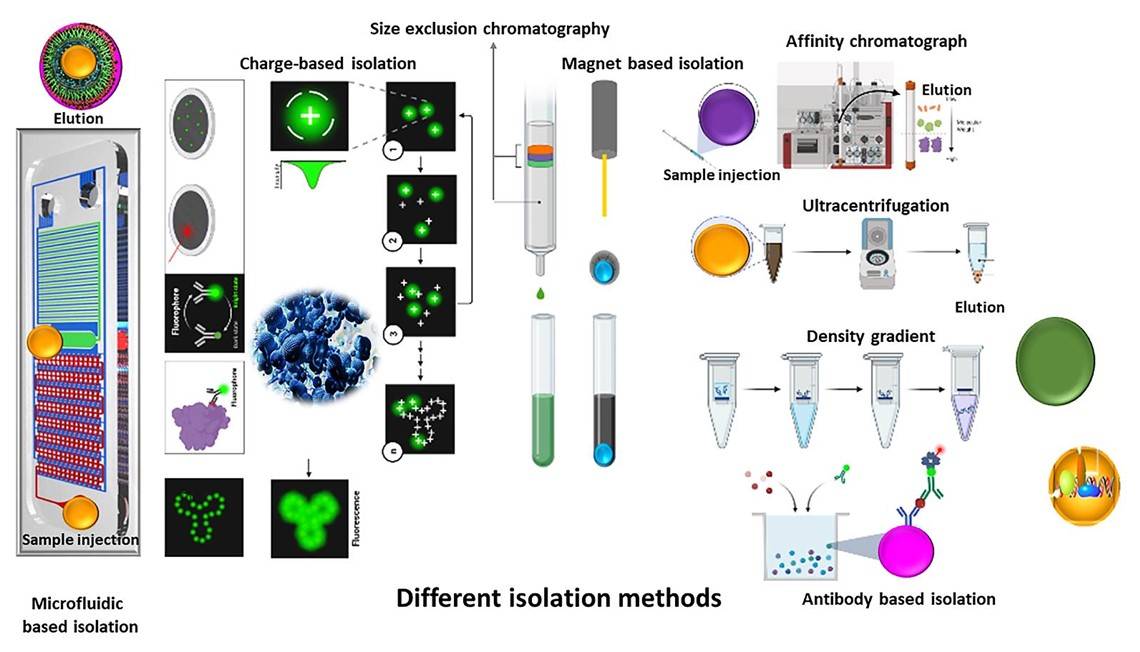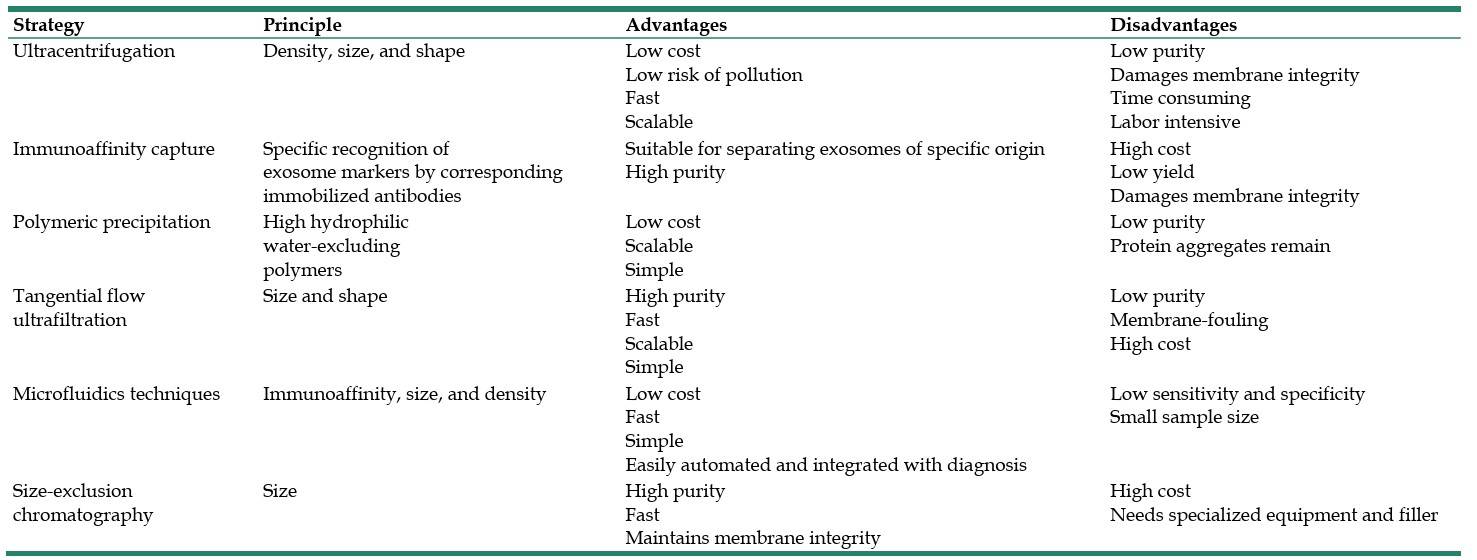Extracellular Vesicle Isolation and Purification Service
Overview Services Features FAQs
Creative Biolabs offers research services related to the isolation and purification of EVs with specialized insights into the development and preparation of EVs.
Overview
Communication between cells based on EVs (extracellular vesicles) is conserved in all life. EVs are lipid-structured vesicles secreted by cells and are widely found in cell culture supernatants as well as in various body fluids (blood, cerebrospinal fluid, saliva, urine, breast milk, etc.) EVs are to be separated from biospecimens to exclude background interference from other extraneous molecules. Moreover, the purification of EVs facilitates the improvement of their quality and is a prerequisite for their characterization and further studies.
EVs Isolation and Purification Services
At Creative Biolabs, the EVs isolation platform supports the isolation of EVs from various sources, with available isolation methods including but not limited to:
-
Differential centrifugation: EVs would be separated by gradually increasing the centrifugal force or centrifugal time according to the differences in the settling coefficients of vesicles, cells, cell debris and protein molecules in solution. Differential centrifugation is a classical method for the isolation of EVs from various types of samples for functional studies and marker screening. The efficiency of differential centrifugation for the separation of EVs also depends on factors such as acceleration, rotor type, and viscosity of the sample. Therefore, the parameters are adjusted appropriately according to the sample type to obtain high-purity EVs.
-
Density gradient centrifugation: Based on the difference in density and size between vesicles and other biomolecules, EVs are separated from protein aggregates and non-membrane particles by adding separation media such as sucrose and iodixanol to stay in different gradient layers in solution. The method has high separation purity, and the buffering effect of separation media can also reduce the damage of EVs by centrifugal force, appropriate for functional studies of EVs, marker detection, and determination of contents.
-
Precipitation: Depending on the physicochemical properties of the compounds and EVs, EVs are isolated by co-precipitation or reverse screening, which mainly includes polymer precipitation and organic solvent precipitation. Polymer precipitation is a method that uses the hydrophobicity of membranes and associated water-soluble compounds to competitively bind water molecules to co-precipitate hydrophobic protein and lipid molecules, suitable for samples with RNA analysis.
-
Microfluidic: These include capture microfluidics, filtration microfluidics, magnetic separation microfluidics, acoustic separation microfluidics, and dielectrophoretic microfluidics. The microfluidics-based methods are emerging techniques for the separation and detection of EVs, and the advantages of automation make it extremely advantageous in the biological function study of EVs and clinical diagnosis of diseases.
 Fig.1 Schematic representation of different methods for extracellular isolation and purification.1, 3
Fig.1 Schematic representation of different methods for extracellular isolation and purification.1, 3
Meanwhile, Creative Biolabs offers diverse EV purification strategies and services based on size, and immunological properties, including but not limited to:
-
Field-flow fractionation: This is one of the most commonly used particle size-based purification methods. The flowing fluid of the component to be separated is made to flow through a flat strip channel formed by upper and lower flat plates, and a field is applied vertically to the channel. The particles are subjected to both horizontal and vertical flow fields through the channel, with small EVs being subjected to less vertical force and spreading towards the channel center, while large EVs are subjected to more vertical force and moving closer to the accumulated wall, thus creating a size gradient in the vertical direction. The field will cause different components to be at different positions from the lower wall and thus move at different speeds to achieve purification and concentration of EVs. The flow can be passed through asymmetric fields such as electric, gravitational, thermal or semi-permeable membranes. The technique possesses low or no shear effect due to the absence of a stationary phase and the relatively low system pressure. Since no expensive equipment is required, it is suitable for large-scale purification and volume concentration of EVs.
-
Size-exclusion chromatography: A method for the purification of particles of different sizes based on the different velocities of the different particle sizes during the passage through the porous polymer gel packing. The purification of EVs is performed by gravity rather than centrifugal force, thus avoiding the aggregation of EVs caused by centrifugal force and the impairment of EVs membrane integrity and bioactivity.
-
Immunoaffinity: Based on the antigen-antibody immune reaction, the antibody specifically binds to the corresponding antigen on the surface of EVs to achieve the capture and purification of EVs. One of the most representative purification methods is the magnetic bead-based affinity method, whose main advantage is that magnetic beads provide a larger surface area for capturing EVs and improve purification efficiency.
 Tab. 1 Comparison of EVs extraction and purification techniques.2, 3
Tab. 1 Comparison of EVs extraction and purification techniques.2, 3
Features
-
Advanced Technology: Employ dependable techniques to accurately isolate and purify extracellular vesicles.
-
Customized Protocols: Tailor protocols to suit specific sample types and research objectives, ensuring optimal results.
-
High Yield and Purity: Achieve high yield and purity of extracellular vesicles suitable for downstream applications.
-
Quality Control: Rigorous quality control measures to maintain consistency and reliability of isolated vesicles.
Creative Biolabs has accumulated insights into traditional and emerging methods for the isolation and purification of EVs, as well as proficiency in the suitable conditions and application prospects of each isolation approach. Our scientific team provides customized EVs isolation and purification services to advance EVs research. Please contact us to get a quote.
FAQs
Q: What types of extracellular vesicles can be isolated?
A: We specialize in isolating various types of extracellular vesicles, including exosomes and microvesicles, from different biological fluids and cell culture supernatants.
Q: What are the downstream applications of isolated extracellular vesicles?
A: Isolated vesicles can be used for biomarker discovery, drug delivery studies, functional assays, and RNA profiling, among other research applications.
Q: Can you manage projects of a significant size?
A: With flexibility in sample volume and processing capacity, our services are indeed flexible to suit both small- and large-scale projects.
Q: What details are needed in order to submit a service request?
A: We typically require details such as sample type, volume, desired purity and yield, and specific research goals. Our team will develop a customized plan accordingly.
Q: How long does the isolation and purification process take?
A: The timeline varies based on sample complexity and the chosen isolation method. Once the specifics of your project have been evaluated, our staff will offer an approximate turnaround time.
References
-
Akbar, Asma, et al. "Methodologies to isolate and purify clinical grade extracellular vesicles for medical applications." Cells 11.2 (2022): 186.
-
Chen, Peier, et al. "Targeted delivery of extracellular vesicles in heart injury." Theranostics 11.5 (2021): 2263.
-
Under Open Access license CC BY 4.0, without modification.
For Research Use Only. Cannot be used by patients.
Related Services:

 Fig.1 Schematic representation of different methods for extracellular isolation and purification.1, 3
Fig.1 Schematic representation of different methods for extracellular isolation and purification.1, 3
 Tab. 1 Comparison of EVs extraction and purification techniques.2, 3
Tab. 1 Comparison of EVs extraction and purification techniques.2, 3









